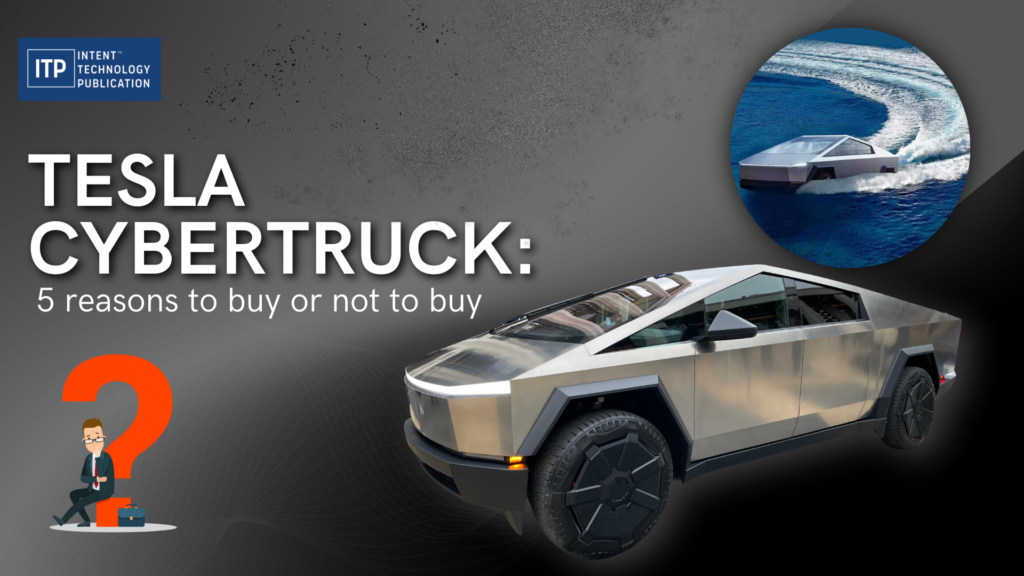or call: +1 (520) 350-7212

or call: +1 (520) 350-7212
or call: +1 (520) 350-7212

You can find plenty of blogs, about why you should buy a Cybertruck and why you shouldn’t. In this blog, we have 5 points to discuss and the 5 points are the same you should, why you should not buy a Tesla cybertruck.
The Tesla Cybertruck transcends the realm of standard pickup trucks, standing as a testament to Tesla’s imaginative brilliance and groundbreaking engineering in the electric vehicle domain. Conceived from the visionary mind of Elon Musk, the Cybertruck represents a radical departure from traditional design, embracing an unprecedented exoskeleton and armor glass with bulletproof capabilities.
This innovative journey commenced with Tesla’s unwavering commitment to pioneering advancements, sustainability, and the constant drive to redefine the limits of automotive engineering. Through meticulous research and development, the Tesla team birthed a vehicle that not only challenges norms but also serves as a beacon for the future of electric mobility.
According to TimesNow, The imminent release of the Tesla Cybertruck to customers has sparked anticipation, with a recent report projecting a notable uptick in deliveries by 2024. According to the report, Tesla is expected to dispatch approximately 100,000 to 120,000 units in 2024, with a subsequent surge to an estimated 240,000 to 260,000 units in 2025.
The Tesla Cybertruck has stirred both excitement and skepticism, presenting a unique blend of features that fuel debates about its suitability. Let’s dissect the pros and cons of this futuristic pickup.
With a base model under $40,000, Tesla targets a significant share of the pickup market. Projected longevity exceeding 750,000 miles makes it a sound investment. Lasting 50 years with average use, the Cybertruck offers unparalleled value compared to competitors.
Weight estimates range from 5,000 to 6,500 lbs. Factors contributing to this mass include the vehicle’s size, stainless steel body, and hefty battery packs. The combination of size, weight, and handling dynamics becomes a critical consideration for potential buyers.
Undoubtedly, the Cybertruck promises ‘supercar performance,’ reaching 0-60 mph in less than 2.9 seconds with the tri-motor variant. A Lamborghini Aventador LP750, twice the price, achieves a 0-60 mph time of 2.7 seconds. Supercar performance indeed, though driving an armored tank at such speeds raises interesting considerations.
While exact dimensions remain undisclosed, the Cybertruck is a full-size pickup, estimated at 230.9 inches in length. Maneuvering this substantial vehicle, demonstrated by Elon Musk himself, poses challenges. Poor visibility led to a collision with a traffic bollard, highlighting the truck’s bulkiness.
The Cybertruck’s rear tray introduces innovative features. Adaptive air suspension facilitates easy loading by lowering the rear. The ‘vault’ design provides 100 cubic feet of lockable storage, surpassing competitors like the Ford F150.
Boasting a 14,000 lbs towing capacity, the Cybertruck’s capability is doubted. Electric vehicles, in general, face towing challenges due to the limited energy density in current batteries. Range reduction while towing poses concerns, demanding vigilant battery management.
Ordering before 2021 allows for the ‘Full Self Driving’ option at an extra $7,000. While many cars offer autonomous features, ‘full self-driving’ remains a distinct category. Despite uncertainties around regulatory approval, this option sets the Cybertruck apart.
The current Cybertruck may face road-use challenges due to safety concerns. The lack of apparent crumple zones, unconventional lighting, wide protruding tires, and the absence of side mirrors raise regulatory eyebrows. Meeting safety standards requires substantial adjustments.
Several vehicles, including GM trucks in the 2000s, featured rear-wheel steering. This functionality is particularly practical for extended pickups like the Cybertruck, offering improved maneuverability in tight urban spaces and parking lots.
When purchasing a car, a crucial consideration is its long-term durability, especially over the seven years post-purchase. Many cars have proven to outlast the duration of loan payments. The concern arises when acquiring a new car, particularly one not yet released to the public, as uncertainties linger about its longevity. Cars represent significant investments, though the return may not match the initial cost. Despite this, they contribute to the creation of cherished memories. The Cybertruck, with numerous uncertainties, prompts hesitation in making a confident purchase before witnessing its proven durability over time.
The Tesla Cybertruck is a polarizing innovation, offering unprecedented features alongside potential drawbacks. As it navigates through safety concerns, regulatory compliance, and practical considerations, its impact on the pickup market remains to be seen. The blend of groundbreaking technology and unconventional design creates a unique proposition, inviting enthusiasts and skeptics alike to weigh the pros and cons before embracing the future of pickups.
